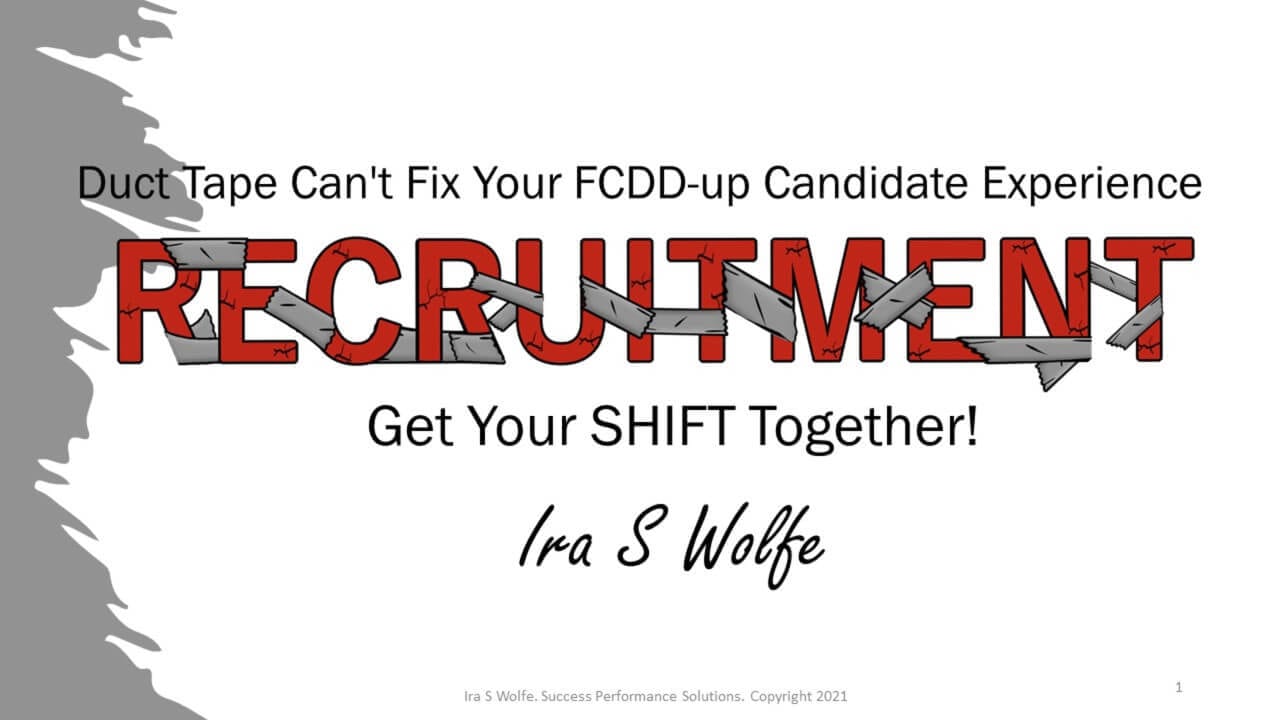
Not Enough Job Applicants? Your Candidate Experience May Be All FCDD-up!
Imagine this. Your company launches a massive sales and marketing campaign that you’ve been planning for months. You blast out emails and texts, engage customers on social media, and promote your sale by billboards, TV, and radio. After a few days, all you hear is crickets. Everyone’s attention and blame turn to your marketing department and agency.
But what if marketing did their homework and implemented a genius plan and the problem wasn’t a failure to reach and engage potential buyers BUT customers faced nothing but frustration, confusion, distraction, and disappointment when they clicked to buy?
Welcome to HR and Recruitment 2021.
While COVID19 fears subside, labor shortages have emerged as the #1 threat to business recovery and growth. The demand for workers is surging. The supply of qualified workers is shrinking. Wages are rising at the fastest rate in 20 years and quit rates are accelerating at historic levels. Filling open jobs with qualified workers seems like an unsolvable task.
The last thing any company can afford to do is deliver a candidate experience that frustrates, confuses, distracts, or disappoints a potential employee. And yet despite all the recruitment and media attention focused on the jobseeker these days, the state of the candidate experience in many organizations can be summed up in just a few words:
Your Candidate Experience is All FCDD-up!
FCDD is a four-letter mnemonic created by CX and UX strategist Debbie Levitt to represent what she calls the Four Horsemen of Bad CX: frustration, confusion, disappointment and distraction. These four horsemen represent candidate exasperation: four emotions that candidates emit when they attempt to interact with your company website and application. These four horsemen almost single-handedly crush the engagement of up to 9 out of 10 candidates who want to work for you but quit before applying.
Too often companies believe that the candidate experience (CX) journey starts after a candidate applies for a role at your company. But it actually begins long before that and includes every interaction, passive or active, between you and the candidate.
Often ignored but critical touchpoints include your career site’s mobile-friendliness, page speed, responsiveness, the colors you use, your navigation, the feel and mood of your brand, your applicant workflow, buttons, menus, errors, voice commands, and even employee and customer reviews. It encompasses your job listings, your applicant tracking system and job application, your response to candidates, and the speed of that response. It also includes the interview, the preparation of your hiring managers, and onboarding. Each of these touchpoints is vulnerable to a bad customer experience and therefore presents an opportunity to beat your competition—or risk disengaging candidates.
Fortunately, many of the fixes for bad CX are low-hanging fruit, requiring little or no budget and minimal expertise or resources. Here are some of the most blatant examples of bad CX I’ve seen over the past year—and how to fix them.

1) Frustration
According to The Talent Board, the #1 reason that job candidates don’t apply or withdraw from your hiring process is that the application is too long or difficult to complete online. The length of your application matters. Remember that nearly 3/4 of all job searches begin on a mobile device. For many workers under 30, a smartphone may be their only connection and pathway to apply. Application rates drop by 365% if it takes more than 15 minutes to complete. What’s more, applications with more than 20 questions lose 40% of applicants. More than 45 questions? A whopping 88.7% of applicants are gone.
Another pet peeve for candidates is the failure of many sites to save the application information they provided if they are interrupted and need to finish it later.
Solution: Make sure your career pages, job listings, and application meet the minimal encryption standard (SSL). Create a short and simple screening application. Then, if the applicant is qualified, invite to complete your longer application. Provide progress bars and “save for later” functions so that candidates can take breaks during the process and return right where they left off.
2) Confusion
In a review of 100 random company websites, I discovered that only 13 had a clear pathway from the home page to their career site. Because over 61% of job seekers visit your website before applying to a job at your company, it’s critical that you make it easy and convenient to jump from the home page to the career site. On most websites a “careers” link was buried at the bottom of a long page in the footer. Others included it in a drop-down menu under “About Us” and “Resources.” Finding a career shouldn’t be a game of Where’s Waldo.
In addition to having trouble finding the careers page, many applicants suffer from bad UX and technological difficulties during the application process. More than half of respondents to a recent study said they have encountered a technical issue, error or have been unable to complete the search and application process, which ultimately led them to abandon the application.
Solution: If you’re having trouble hiring qualified workers, stop playing hide-and-seek with your career site. At a minimum, “careers” or “jobs” should have their own button on the navigation. Add it to your header, especially if you have a rotating carousel of images. And make sure all your career pages, links, registration forms, and apps work.


3) Disappointment
One of the biggest job seeker pet peeves is the “HR black hole.” 52% of candidates were still waiting for a response three months after applying, while 63% of job seekers say they are dissatisfied with the communication from most potential employers. As a result, nearly 7 out of 10 candidates would rarely or never reapply to a company that doesn’t communicate well, and 69% of them would discuss the poor candidate experience with a friend or colleague, which may deter others from applying to roles at your company as well.
UX and web/mobile design can also impact the candidate experience. 70% of job seekers use a mobile device to search and apply for a job, but fewer than 40% of career sites and applications are mobile-ready. If your site isn’t optimized for mobile, you’re missing out on promising candidates.
Solution: Responding to candidates is easy. With chatbots, text messaging and auto-responders, there is no longer an excuse for delayed responses or failure to keep candidates informed about their application or interview status. Companies need to enter the 21st century and make their career pages and applications mobile-friendly. This has become increasingly important, especially since Google instituted the mobile-first update in 2018, which now indexes mobile sites and in some cases, grants them preference in search results. Google’s just-released May 2021 update released a tectonic shift in terms of how and what content will ever meet your candidates’ eyes. SEO (search engine optimization) isn’t just for your customers. It applies to your career pages, job listing, and job application too!
4) Distraction
A career page is your home base for all things talent acquisition. Once a candidate lands on this page, don’t distract them with widgets and banners to sign up for sales, newsletters, and non-job relevant activities. Keep the candidate focused on learning about the job opportunity.
For anyone who has followed me, you know I’m a huge proponent of using video and images to attract candidates. But these items can easily slow down your page speed, especially on mobile devices. Now that Google plans to add the “badge of shame” to pages that take too long to load, it’s more important than ever to keep your career pages, job listings, and applications fast and responsive.
Solution: Engage candidates, but don’t over-entertain them. The goal is to advance him or her from visitor to applicant. Keep your job listings tight and focused on what’s relevant. Avoid long applications with non-relevant or redundant questions which can be distractions, too. Use video and images but compress them or host them on sites like Vimeo and YouTube.
Making these small changes could do wonders to boost your talent pipeline and fill jobs faster—and they’re not hard to implement. Start with the easiest tweaks first and resolve to fix the bigger issues as soon as possible.


